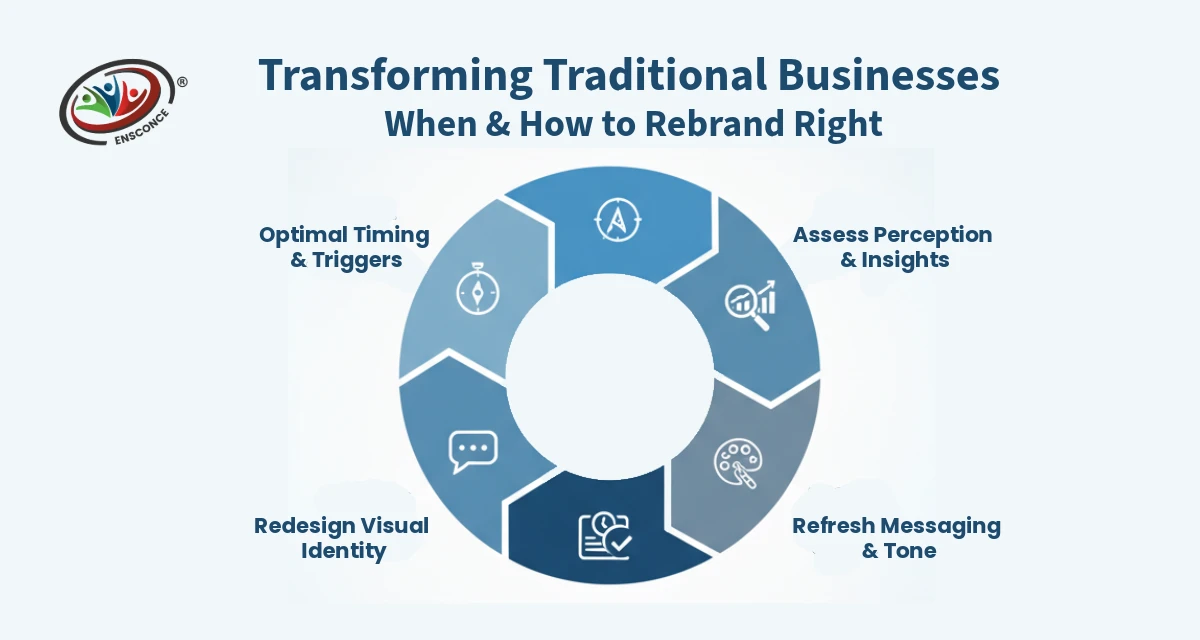Transforming Traditional Businesses: When and How to Rebrand Right
Rebranding a long-standing business is not just about creating a new logo or choosing a better colour. It is about reshaping how customers experience your company and how strongly they trust your promise. Many traditional businesses struggle with the shift from "this is how we have always done it" to "this is what makes sense today". At Ensconce, we help organisations make this journey confidently, with clarity, strategy, and measurable outcomes.
A good rebrand feels like evolution, not replacement. It protects your history while helping you stay relevant in a changing market.
When Should You Consider Rebranding
Not every update qualifies as a rebrand. You should evaluate the need when these situations appear:
- Market shifts: New players and technology change how customers expect service.
- Business direction change: A merger, acquisition, or new product strategy.
- Reputation challenges: Ongoing perception issues that small fixes cannot correct.
- Visual mismatch: Your brand looks old compared to the quality you deliver.
If two or more of these apply, it is time to plan a structured rebrand.
Clarify Brand Purpose and Values
Before visual work begins, be clear about who you are.
- Why do we exist: Beyond sales, what value do you create?
- Where are we going: Your focus for the next three to five years.
- How do we behave: The values that guide daily decisions.
Capture this in a short purpose statement and three core values. These will drive messaging and employee alignment.
Understand Current Brand Perception
Without real customer feedback, assumptions become risky. Use both data and conversations to build clarity.
- Customer surveys and NPS: Measure satisfaction and track trends.
- Interviews and staff insights: Enterprise customers, sales teams, and support teams reveal daily reality.
- Competitor view: Where you stand in the current market landscape.
The outcome should highlight the perception gap: what you claim versus what customers experience.
Refresh Your Visual Identity
Your visual identity should show progress and confidence, while holding on to your brand story.
- Keep recognisable elements: Colours, motifs, or shapes connected to your heritage.
- Simplify and modernise: Clean systems work better on websites and mobile screens.
- Create a brand kit: Logo formats, colour palettes, fonts, icons, and rules.
This ensures consistency across platforms and reduces interpretation errors.
Update Brand Messaging and Tone
How you speak influences how customers feel.
- Tone of voice: Decide if you are expert, friendly, calm, or bold.
- Audience messages: Prospects, existing customers, and partners require focused communication.
- Short scripts: Give sales and service short, clear lines to explain "why it matters".
Create a library of standard responses to maintain consistency across teams.
Maintain Consistency Across Touchpoints
Your brand appears in more places than you imagine.
- Audit every touchpoint: Website, invoices, email signatures, storefronts, packaging, sales decks.
- Rollout checklist: Prioritise the most visible items first.
- Central asset repository: A single library avoids outdated versions.
Even small inconsistencies can create doubt in the customer's mind.
Use Digital Channels As a Strength
Digital platforms amplify your new identity faster than physical spaces.
- Website relaunch: Better user experience, clear content, and updated visuals.
- Social alignment: New profile visuals and a pinned explanation post.
- Targeted campaigns: Reach old customers and new audiences effectively.
Measure traffic, engagement, and conversion numbers before and after launch to show impact.
Engage Employees as Brand Ambassadors
Your people carry your brand every day. They must understand what changed and why.
- Workshops and orientation: Explain purpose, visual changes, and customer value.
- Quick guides: FAQs and messaging sheets for internal use.
- Recognition programs: Reward employees demonstrating brand behaviour.
When employees feel ownership, adoption happens faster.
Communicate Change Carefully
The biggest risk is confusion. Plan communication in a clear sequence.
- Internal first: Employees should never hear from outside sources.
- Key partners next: Share personalised communication to maintain trust.
- Public announcement: Blog, press note, and social updates.
- Follow up messaging: Short updates explaining benefits and improvements.
Always tell customers what remains consistent. Stability reduces fear.
Track Performance After Rebranding
Measuring impact shows whether your efforts are working.
- Brand metrics: Search trends, awareness, and social visibility.
- Customer metrics: NPS, churn rate, and lead conversions.
- Internal metrics: Adoption rate of templates, tone, and assets.
Review performance monthly for six months, then quarterly.
Learn from Modern Rebrand Examples
Look at companies that evolved successfully.
- What changed: Visual identity, messaging, digital experience.
- What stayed: Core promise and service standards.
Focus on strategy, not design imitation.
Align Branding with Business Transformation
Branding is not just visual decoration. It supports business outcomes.
Link brand investments to:
- Revenue growth
- Customer retention
- Market expansion
- Product adoption
Leadership commitment ensures the rebrand does not fade after launch.
Leverage Your Potential. Take Action Today.
Rebranding a traditional business requires research, planning, and consistent execution. When decisions are anchored in purpose, backed by customer insight, and supported across digital and human channels, a rebrand becomes a meaningful transformation.
If your legacy brand is ready to evolve without losing its identity, Ensconce can help build a strategy that respects the past and accelerates future growth.
� Contact us to schedule a brand health review and receive a practical step-by-step plan.
Let us help you transform your traditional business brand into a modern, trusted, and competitive force in your market.



